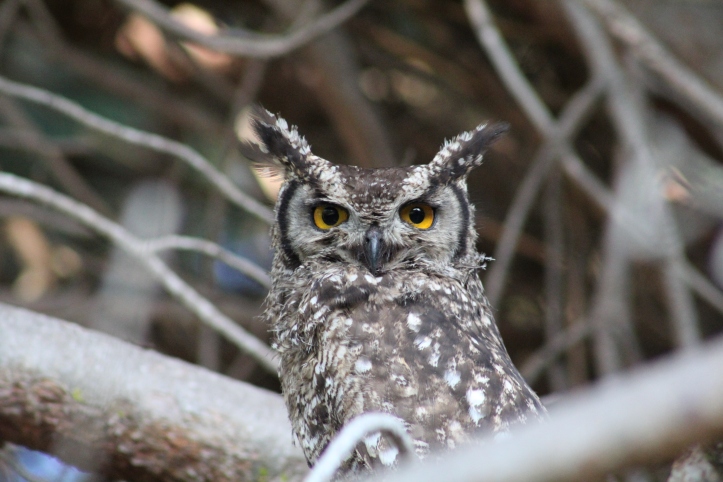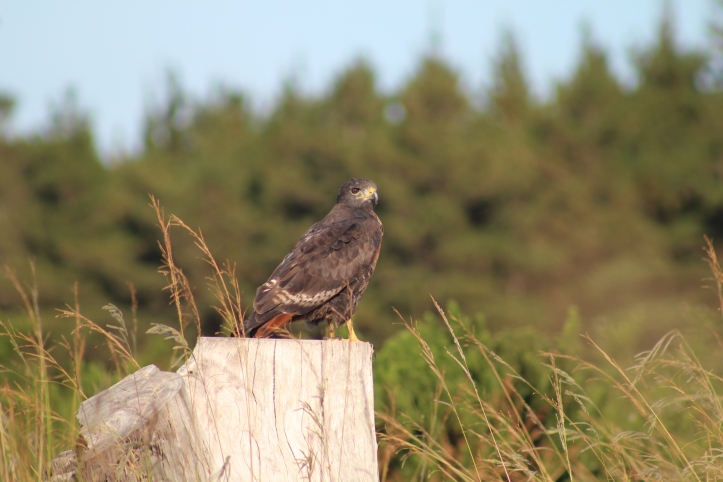I live just down the road from Tokai Park, an area of Cape Flats sand fynbos that is being restored to its former state. When I first arrived in Tokai it was mostly pine trees with little life. But since most of the pines were cut down i have been able to watch the fynbos grow back and now the area is transformed. This restoration has also led to an increase in the areas bird life. The fact that Tokai park has extensive areas of fynbos and wetlands along with woody gardens and patches of large trees (both native and exotic) means that a variety of birds can occur here and over the last four years I have helped Friends of Tokai park compile a list of 101 bird species for Tokai (most of which I have seen) and have had some of my most memorable bird encounters in Tokai.
If I were to walk through the fynbos, I would without a doubt hear Karoo prinias singing to each other and spot a fiscal shrike perched on a bush. On most days I spot one or two pairs of jackal buzzards circling above the fynbos or the wetlands, crying out with a call eerily similar to that of a black-backed jackal (hence the name). Sometimes, rock kestrels will hover over the fynbos and perch on the old eucalyptus stumps. There are three wetlands in and around Tokai park, namely Keysers River, Soetvlei and Prinseskasteel. The reeds here are home to levaillant’s cisticolas and large flocks of common waxbills, which are usually joined by one or two swee waxbills. A few cape and masked weavers live in Keysers, along with large numbers of cape bulbuls and pin-tailed whydahs. Next to Soetvlei there is a large patch of whorl heaths growing which, when they’re flowering, attract large numbers of southern double-collar sunbirds. Added to that, the reeds next to them are home to a flock of yellow bishops and a pair of grassbirds also frequent the area too. Little rush warblers are often heard calling from reeds but are hardly ever seen.
In summer, the bird population gets a boost from visiting summer migrants. African paradise flycatchers arrive and brighten up the surrounding gardens and patches of trees with their songs and the males extravagant plumes. White-throated, greater striped and barn swallows, and white-rumped swifts join the black saw-wings and the little and alpine swifts. Together, these birds swarm above the park, snatching up flies from the swarms that gather before and after the rains. Steppe buzzards and yellow-billed kites fast become the most common birds of prey in the area.
I have followed three bird families in the last four years, all three of which were (or are in one case) extremely thrilling experiences. In 2014, a pair of red-chested sparrowhawks tried to nest in the last patch of pine forest left in Lower Tokai. It was the first time I had ever seen these birds and I was ecstatic. The female always perched high up in the pine trees but the smaller male had a habit of perching in the lower branches, sometimes with a kill, which allowed me to get very close to him. Last year a pair of spotted eagle-owls managed to raise a single chick on the edge of the plantation. Every day for several months I would find them without fail and this gave me some of my most memorable owl encounters including the day when I found the chick on the ground, having fallen out of the nest (fortunately the next day it was back up in the tree with its parents). But perhaps the bird family that I have followed most consistently are the pair of black sparrowhawks that have a nest on the edge of the plantation. I have followed these birds for the last three years and have seen them raise chicks, hunting, fighting, mating and even make a kill right in front of me (to fully tell their story, I will be writing a separate blog about these birds). This year the pair are currently raising three chicks, which are growing up fast.
Over the last three years, I have been extremely lucky to spot a number of elusive and rare birds in this area. Perhaps the most notable was in January this year when I spotted a young male orange-breasted sunbird feeding on the whorl heaths nectar alongside the double-collars. According to Tony Rebelo of SANBI, this was the first of that species to be recorded in Lower Tokai Park in 17 years. A year ago, I was also lucky enough to spot a male olive woodpecker near Prinseskasteel Wetlands, where I have also seen a Cape siskin and a group of grey-headed sparrows. A pair of African fish eagles occasionally fly over the park, which I can usually only identify by their haunting cry. Twice I have flushed fiery-necked nightjars from their daytime roosts and I have occasionally heard the bubbling call of the Burchells coucal (but only seen them once). I once had a series of sightings of olive pigeons near the Porters Market and once caught sight of a lanner falcon hunting over the fynbos. When a temporary pan filled up next to Keysers River, a pair of Cape shovelers and, bizarrely, a pair of red-billed teal each showed up for a day. I’ve spotted African spoonbill and a purple heron in Maryland Stream next to the park and spotted a roosting wood owl in the same area too. Other residents of Tokai have even been able to see black-crowned night-heron, lesser honeyguide, barn owl and even verreaux’s eagle.

One of the resident black sparrowhawks finishing her kill

A young orange-breasted sunbird-the first to be seen in Lower Tokai in 17 years.

A spotted eagle-owl perches near its nest

A yellow-billed kite spending its summer in Tokai.

Little rush warbler- a brief photographic opportunity

African olive pigeon near the Porters Market

Cape grassbird returning to a patch of regenerating fynbos-the pine branch is left-over from the logging

Red-billed teal-a very rare sighting for Tokai

Black-headed heron patrolling the edge of Soetvlei wetlands

Olive woodpecker-a first for Tokai

Jackal buzzards are the most common of the birds of prey that hunt in the fynbos.

Levaillant’s cisticola-very common in the wetlands
all but two of your images are broken links, which is sad.
Fascinating list of birds, instead of pine trees!
LikeLike
Oh dear. I’m sorry that happened, I’m not sure why.
Thanks though!
LikeLike
wonderful – both your pictures – and that the birds are returning!
LikeLike